




How to Solve Subtraction Problems with Easy Steps and Examples
Subtraction is an operation in which we take something out of a collection of objects. For example, taking out 4 mangoes from 7 mangoes. It is an arithmetic operation between two numbers. It has great significance in mathematics since it forms the base for our mathematical understanding. Let us learn how to subtract the numbers.
What is Subtraction?
It is an arithmetic operation that signifies the removal of several objects from a collection. In other words, suppose you have 5 Apples, and you ate 3 of them, then you are left with only 2 Apples, this course of an arithmetic operation is called subtraction. This is the most basic form of math we use daily. From shopping to handling a business.
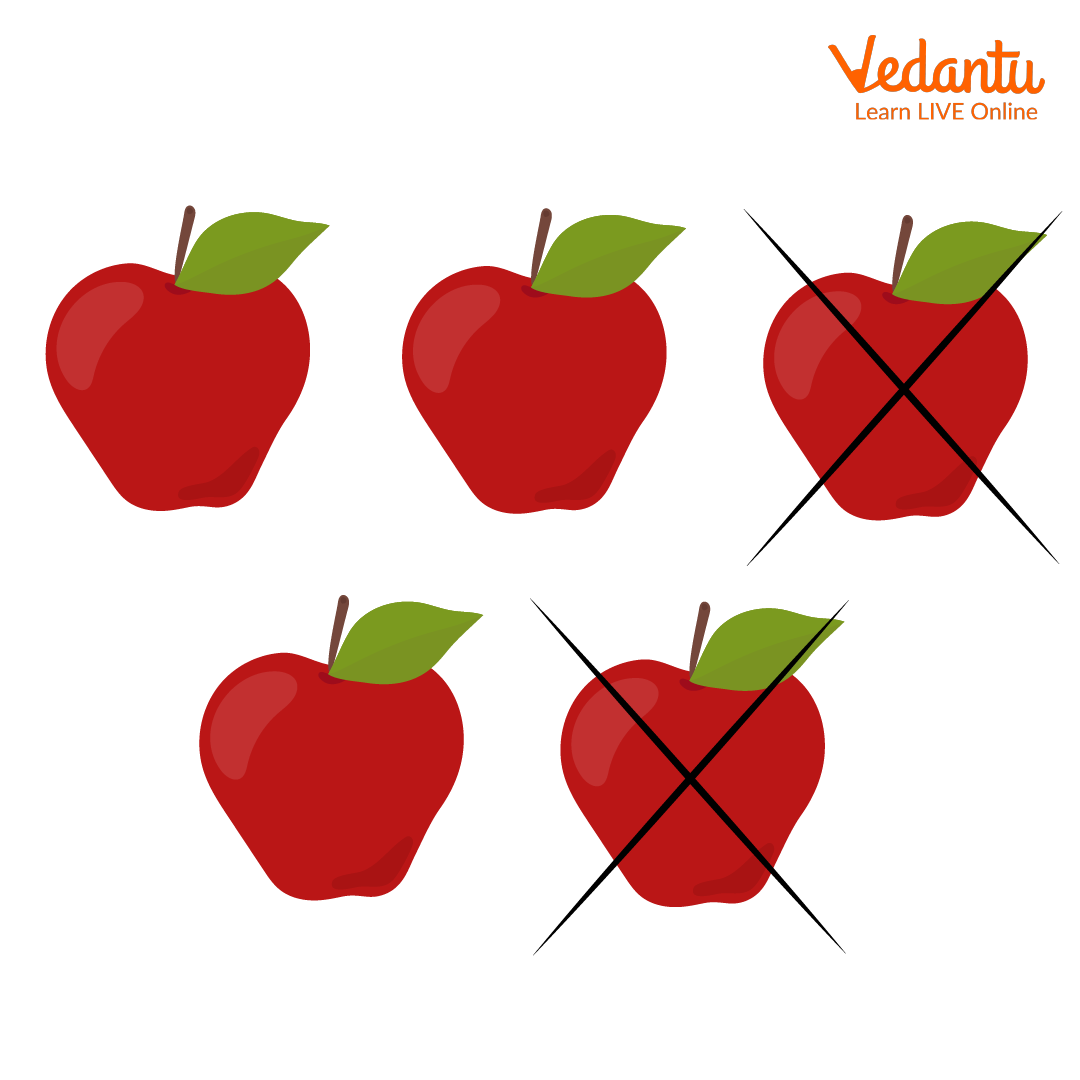
Subtraction
Why is Subtraction Important?
Subtraction is the backbone of the number system. We use it on an everyday basis. Suppose you go to the supermarket to buy vegetables, and the potatoes cost 20 rupees per kilogram, you buy a total of 4 kilograms of potatoes, and you have a total of 110 rupees, then how much are you left with? The answer is simple, you have to pay \[20 \times 4 = 80\] rupees, and you have 110 rupees. After paying 80 rupees to the shopkeeper your balance amount is \[110 - 80 = 30\] rupees. Don’t fret. We will learn how to subtract two numbers in just a moment.
How to Subtract Two Numbers?
We will learn how to subtract two numbers. These are the steps to subtracting two numbers.
Write down the larger the number. Let's take an example where we want to subtract 17 from 32.
Write the smaller number right below, the larger number. Do not forget to line up the ones, tens, and hundreds,... Places. In our case 7 is directly below 2 and 1 is directly below 3.
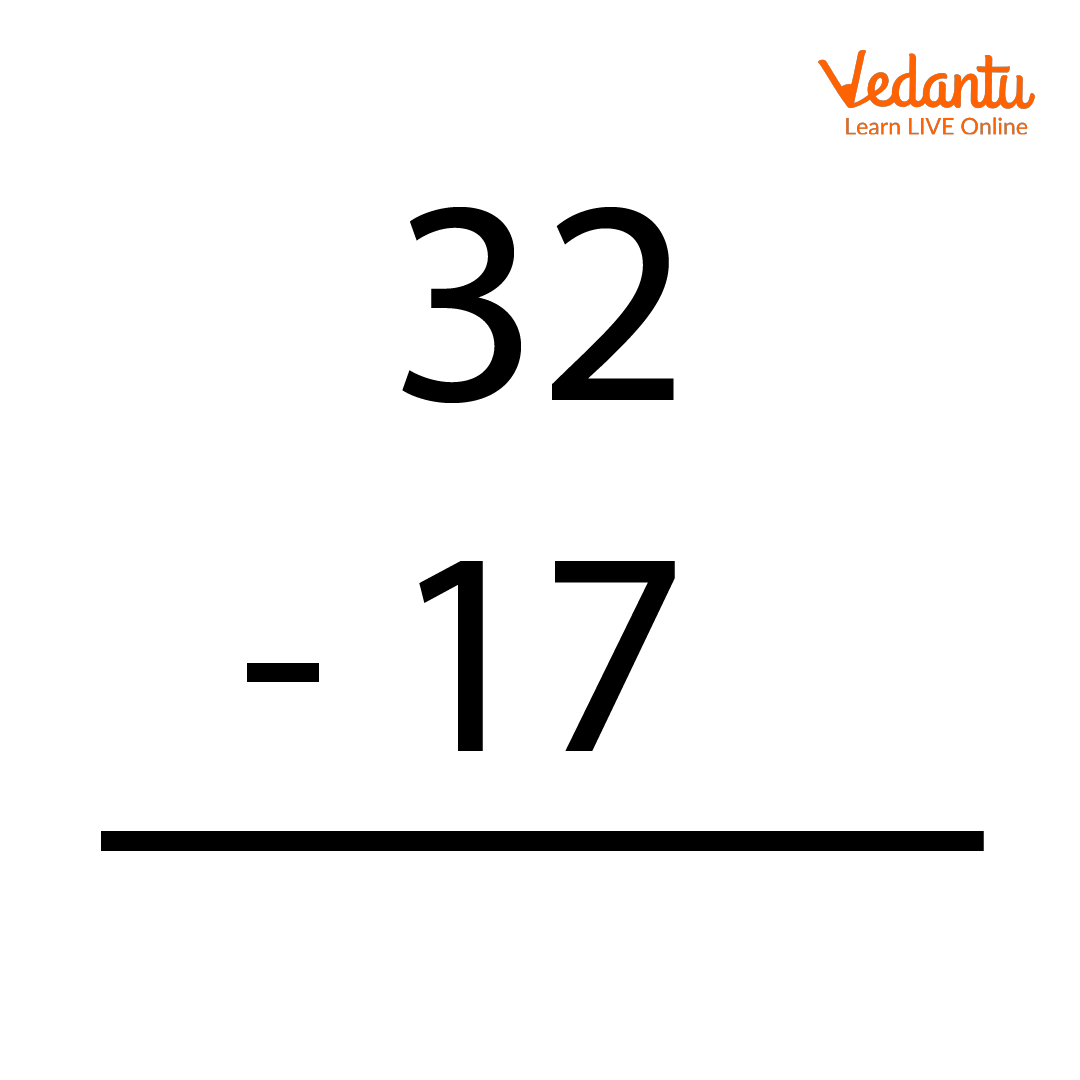
Subtraction
Start subtracting the numbers from right to left. If the digit above is greater than the lower one, we do simple subtraction, and if the number above is lesser than the lower one, we borrow 1 from the digit next to the upper one on the left, cross off the digit and make it 1 less than it was. For example, in our case, we have to subtract 7 from 2, so we borrow 1 from 3, and it makes 12, so instead of subtracting 7 from 2, now we have to subtract 7 from 12, and we also cross off 3 and write 2 in place of it. So \[12 - 7 = 5\].
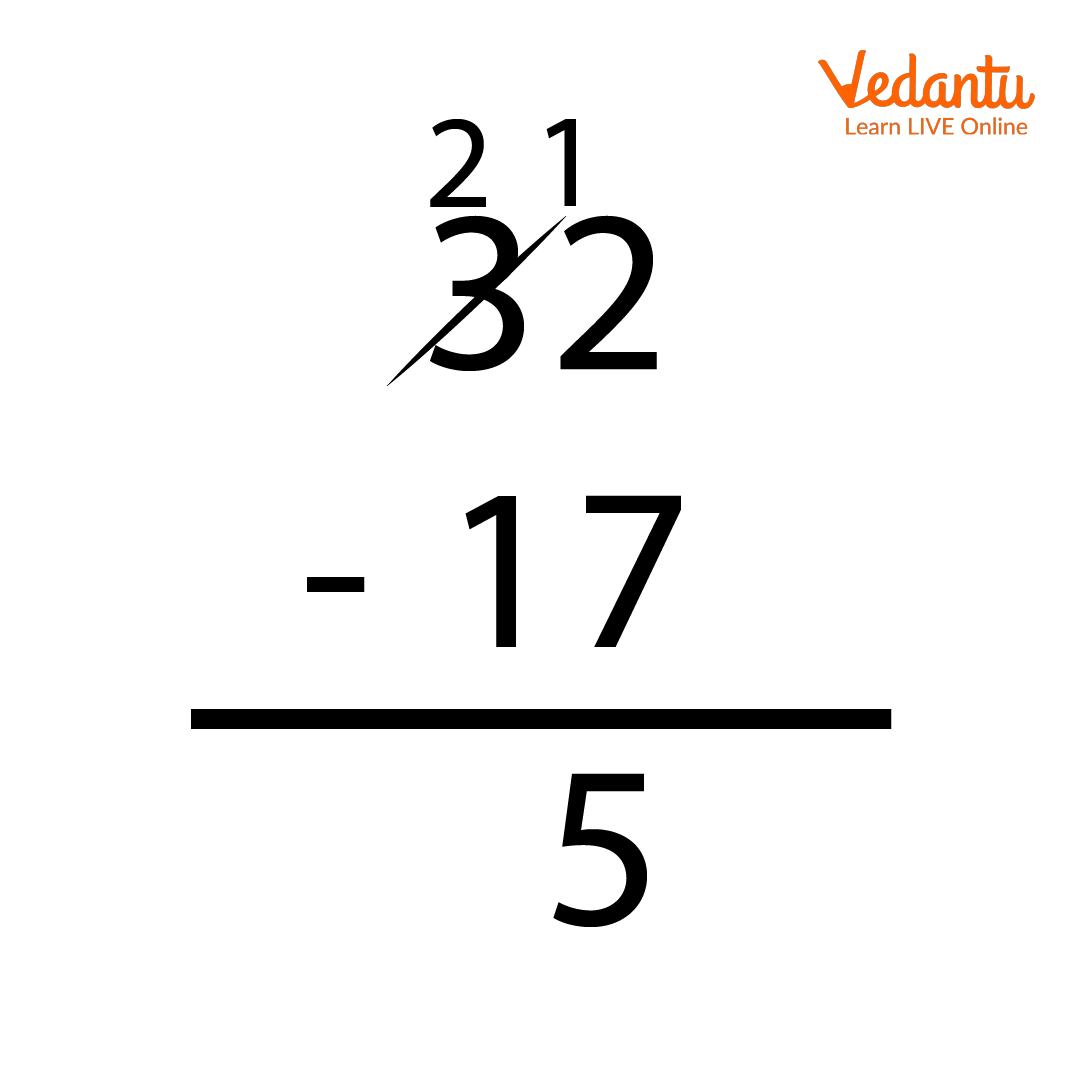
Subtraction
Now we subtract the tens place digit, which is \[2 - 1 = 1\]
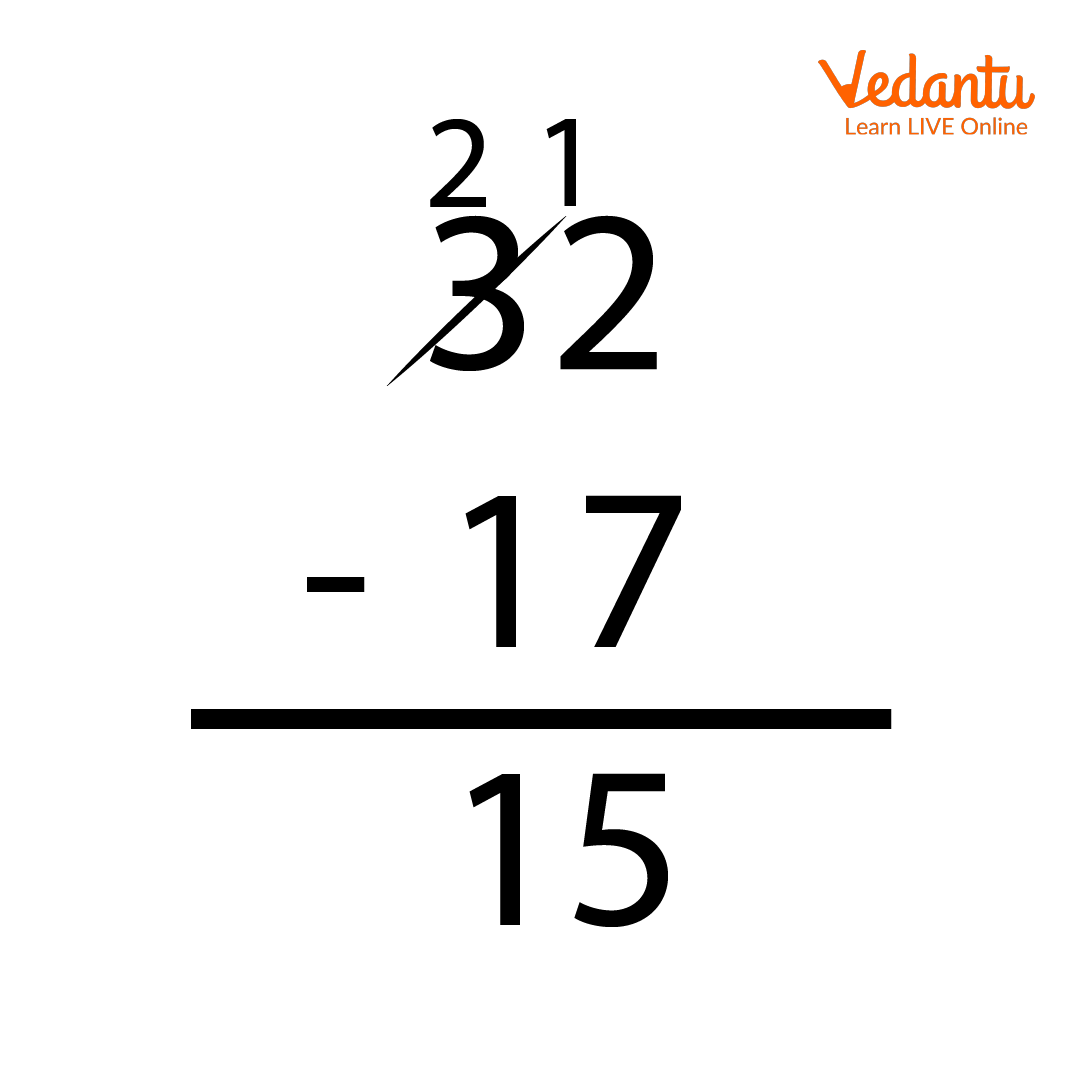
Subtraction
Therefore our final answer is 15. Check the answer, \[17 + 15 = 32\].
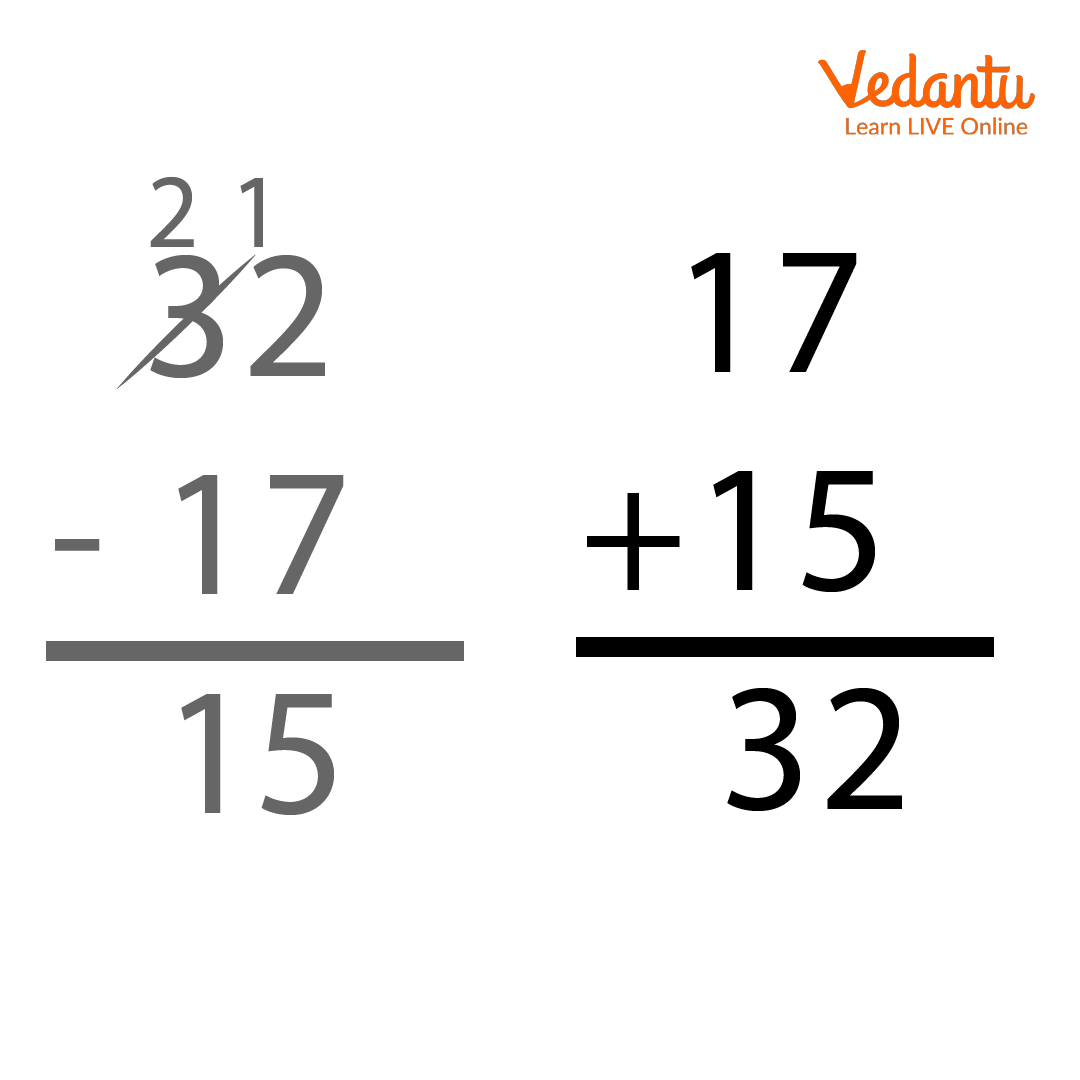
Subtraction
Important Notes
Here are some of the important notes.
If a smaller number is subtracted from a big number, then the answer is always a positive number.
If a bigger number is subtracted from a small number, then the answer is always a negative number.
If a number is subtracted from itself, we get 0 as the answer. For example, 7 subtracted from 7 is 0, and 863 subtracted from 863 is 0.
Great! You now understand what subtraction of numbers is. You have learned how to subtract two numbers and how to do it step by step. Apart from this, you have also learned some important facts about subtraction. Now subtract the following numbers given in the worksheet below:
Solved Examples
1. Sophie has 27 pens, she sold 15 pens out of those 27 pens. How many pens are left at Sophie?
Ans: Sophia has 27 pens, and she sold 15 pens; we can see that the problem asks for the subtraction of two numbers. Here we have to subtract 15 out of 27 to find the number of chocolates left to Sophia. So we have \[27 - 15\]. \[7 - 5\] is 2 and \[2 - 1\] is 1. Hence \[27 - 15\] is 12.
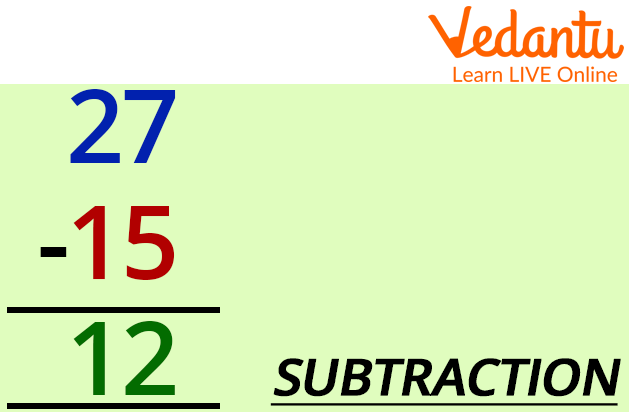
Subtraction
2. It's your birthday, and you have brought 100 chocolates. You have 5 friends; you decided to give them 10, 10,10,20, and 20 chocolates. How many chocolates are you left with?
Ans: This problem asks for two things, first, we have to calculate how many total chocolates has he given to his friends then we will have to find the number of chocolates left by him. So the total number of chocolates he has given is\[10 + 10 + 10 + 20 + 20 = 70\]. Now we have to subtract this number from the total number of chocolates to see how many chocolates are still left. So we have to subtract 70 from 100. 0 - 0 is 0 and then we have \[0 - 7\] in the tens place. 0 is less than 7, so we borrow 1 from 1 and then subtract 7. So \[10 - 7 = 3\] hence \[100 - 70 = 30\]. Thus, only 30 chocolates are left for you.
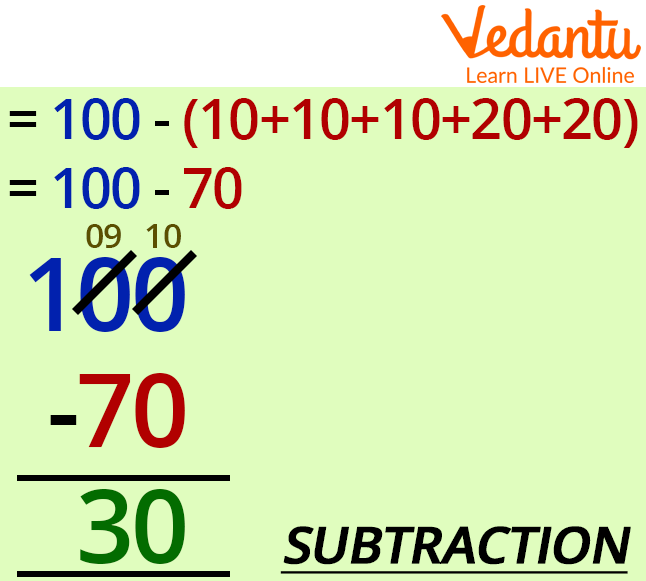
Subtraction
Conclusion
Subtraction is very vital in our daily life. And it is the very base of mathematical reasoning. We use it in many fields of mathematics, as well as in our daily lives. It is a fundamental arithmetic operation, yet the most important is just like addition, multiplication, and division.
FAQs on Subtraction of Numbers Made Simple
1. What is subtraction in Maths, with an example?
Subtraction is one of the four basic arithmetic operations used to find the difference between two numbers. It represents the process of removing items from a collection. The symbol for subtraction is the minus sign (–). For example, if you have 8 apples and you eat 3, you perform the subtraction 8 – 3 = 5 to find that you have 5 apples left.
2. What are the three main parts of a subtraction problem called?
In any subtraction equation, the three parts have specific names:
- Minuend: The number from which another number is being subtracted. It is the initial or larger amount.
- Subtrahend: The number that is subtracted from the minuend.
- Difference: The final result after performing the subtraction.
3. What happens when you subtract a number from itself?
When any number is subtracted from itself, the difference is always zero (0). This is a fundamental property of subtraction. For example, 12 – 12 = 0, and similarly, -5 – (-5) = 0. This rule applies to all real numbers, including integers, fractions, and decimals.
4. How do you subtract multi-digit numbers that require borrowing?
When subtracting multi-digit numbers, you align them vertically by place value (ones, tens, hundreds). If a digit in the minuend is smaller than the corresponding digit in the subtrahend, you must borrow. This involves taking 1 from the next higher place value in the minuend and adding 10 to the current place value. For example, to solve 42 – 17, you cannot subtract 7 from 2. So, you borrow 1 from the tens place (the 4 becomes 3), and the ones place becomes 12. Then you calculate 12 – 7 = 5 (ones) and 3 – 1 = 2 (tens), giving the answer 25.
5. What is the relationship between subtraction and addition?
Subtraction and addition are inverse operations, which means they effectively undo each other. This relationship is extremely useful for checking the accuracy of a subtraction problem. To verify your answer, you can add the difference back to the subtrahend. The result should equal the original minuend. For example, if you calculate 100 – 40 = 60, you can check it by performing the addition 60 + 40, which equals 100.
6. Why isn't subtraction commutative or associative like addition?
Subtraction lacks the commutative and associative properties of addition due to its nature:
- Not Commutative: The order of numbers matters in subtraction. For example, 8 – 5 = 3, but 5 – 8 = -3. Since the results are different, subtraction is not commutative.
- Not Associative: The grouping of numbers also matters. For example, (10 – 5) – 2 = 5 – 2 = 3. However, 10 – (5 – 2) = 10 – 3 = 7. Since the results differ, subtraction is not associative.
7. What does it mean to subtract a larger number from a smaller one?
When you subtract a larger number from a smaller number, the result is always a negative number. This represents a deficit or a value below zero. For example, if you have ₹50 but need to pay a bill of ₹80, you have a deficit of ₹30, which can be represented as 50 – 80 = -30. This concept is vital for understanding topics like temperature below freezing, debt, and elevation below sea level.
8. How is subtracting a negative number different from subtracting a positive one?
Subtracting a negative number is equivalent to adding its positive opposite. The two negative signs effectively cancel each other out and become a positive. For example, 7 – (–4) is the same as 7 + 4, which equals 11. Conversely, subtracting a positive number from a negative number makes the result even more negative, such as –7 – 4 = –11.
9. How is subtraction used in real-life situations?
Subtraction is a crucial skill used constantly in everyday life. Some common applications include:
- Financial Management: Calculating remaining balance after spending money from your account.
- Time Calculation: Determining the remaining duration of a journey or an event.
- Cooking: Adjusting recipe ingredients (e.g., if you have 500g of flour but the recipe needs 200g, you find the remaining amount).
- Shopping: Calculating discounts and change received after a purchase.























